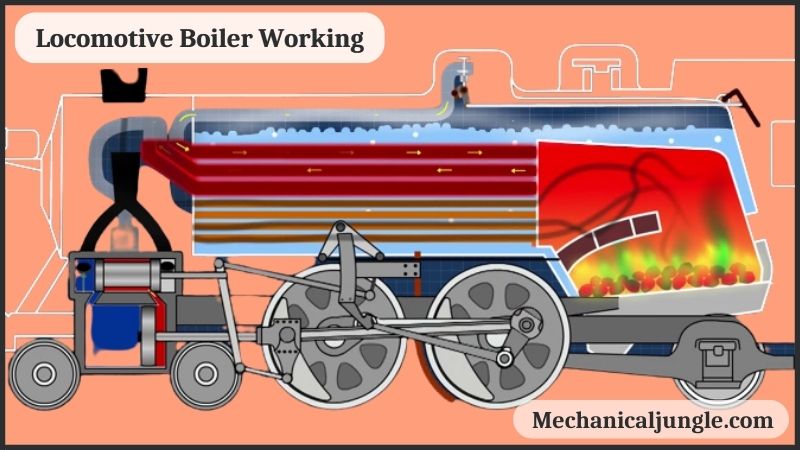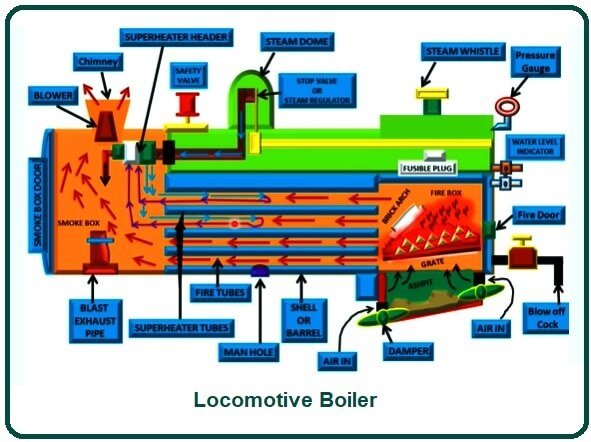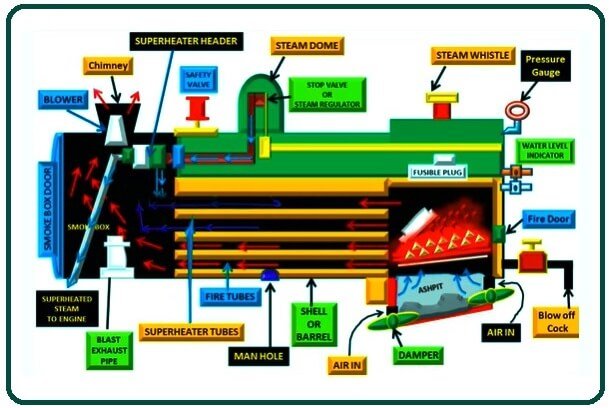
Locomotive Boiler:

The locomotive boiler is a steel shell containing water that is converted from steam heat to fire in the firebox to furnish the energy to move the locomotive. It is a horizontally, multi-tubular, internally fired, natural circulation boiler.
An artificial stream jet draft is present in this boiler to increase the heat transfer rate, which will be seen in detail in the working part of this article.
These boilers have increased back-ends for the firebox. Also, this boiler has about 116 general fire tubes and 38 super-heated fire tubes. It used solid fuels such as coal for its work. The locomotive boiler is a portable boiler, i.e., it can be easily moved from one place to another.
This locomotive boiler can produce a high steam rate & is commonly used in railway locomotive engines and submarines. The first locomotive engine was built in 1803.
Working of Locomotive Boiler:

First, solid fuel (coal) is placed above the enclosure through the fire hole and ignited through the fire hole. As the fuel starts burning in the furnace, hot gases are released from the burning fuel, and these hot gases enter the fire tube. Now the gases will flow through flue pipes and heat these flue pipes.
A fire brick arch exists that provides a passage and direction for the flue gases to reach the flue gases and prevents solid fuel particles from entering the fire tubes. These flu pipes are surrounded by water, and this water will start heating up, and these flue gases will come out of the chimney.
In this way, flue gases will continuously heat the pipe & escape from the boiler through the chimney. Due to the heat received from flue gases, the water will start heating up, and gradually it will start converting into steam.
This steam begins to accumulate in the steam dome. Now, this saturated steam produced by hot water can be used directly or superheated by directing it towards the superheater header.
Now the regulator controls the saturated steam present in the steam dome and helps the saturated steam enter the main steam pipe.
The steam travels into the main steam pipe and reaches the superheater header. After the superheater, the superheat steam will be distributed to the superheater tubes, and this superheat steam enters the steam pipes of the smokebox.
This superhit steam is further used to drive the steam engine and to rotate the wheels of the rail. Steam emanating from the steam engine. Burned gases and smoke reach the smokebox after passing through the tubes of fire.
The exhaust steam coming out of the blast pipe pushes the smoke and burnt gases into the smokebox and drives them through the chimney by removing them from the boiler.
An artificial draft is required for the smoke in the smokebox to come out of the chimney, & this artificial draft is provided by steam emanating from the steam engine. Due to this artificial draft, smoke escapes out of the smokebox, and suction is created to flow hot flue gases.
Parts of Locomotive Boiler:
#1. Boiler Shell
This is the outermost cover of the boiler. Other parts of the boiler are present inside this shell.
#2. Super Heater
These Superheaters are used to heat the steam to a much higher desired temperature before entering the steam engine.
#3. Fire Tubes
Hot gases will flow inside these fire tubes. These fire taps are surrounded by water and exchange heat from the surrounding waters.
#4. Ashpit or Ashpan
The ash of burnt fuels is collected in this ash. It is also known as ashpan. It is applied under the mesh.
#5. Grate
The fuel is burnt on top of the fuel. The melted iron is made of cast iron. There is a vacancy between the grate so that air can pass through it and fuel can burn easily.
#6. Fire Brick Arch
This brick arch is placed on top of the furnace. The main function of these brick arches is to prevent ash, dust, & burnt fuel particles from entering the fire tubes. It also serves as a passage for the flue gases before entering the fire tubes.
#7. Deflector
When the fuel is burnt, the deflector is used to deflect the hot gases generated toward the fire tubes.
#8. Fire Hole
Fuel enters the boiler through these fire holes. Solid fuel usually enters the coal through this fire hole and is placed above the furnace. This hole is provided at the rears end of the boilers.
#9. Fire Box
Fuel is lit inside this firebox.
#10. Smoke Box
In smoke, burnt fuel smoke is collected after passing through fire tubes.
#11. Smoke Box Door
The boilers can be cleaned through this smokebox door.
#12. Blast Pipe
This blast pipe is used to make artificial drafts through the chimney to flush out fumes and make suction for hot flue gases. This suction made by the blast pipe also helps the gases to enter the fire tubes.
#13. Chimney
This chimney of locomotive boilers is small in size, and an artificial blower is used to remove gases from the boiler. This chimney is used to remove exhaust, fumes, and gases from the boiler.
#14. Super Heater Header
The superheater header is used to collect the saturated steam, and this steam is incorporated into the superheated steam, and this superheated steam is passed through the superheater tubes inside the fireboat, which is placed inside the fireboat, And it has a lower diameter than a fire tube.
#15. Super Heater Tubes
These superheater tubes are present inside the fire tubes, which are less in diameter than the fire tubes. Superhit steam produced using superheaters passes through this superheater tube.
#16. Steam Pipe
It is a pipe through which steam passes. We have two steam pipes; There is a main steam pipe between the superheater header and the dome. And the other one is the one that connects the superhit exit end to the steam engine.
#17. Regulator
This regulator is used to supply steam when the operator pulls the lever. It controls steam through the main steam pipe for superheating.
#18. Safety Valves
Safety valves are used to blow off excess steam when the pressure in the boiler exceeds the safety level and prevents the boiler from being destroyed.
#19. Blow Off Cock
Blow-off coke is used to remove or discharge soil and sediment. It is also used to shut off boiler water.
#20. Exhaust Steam Pipe
This exhaust steam escapes from the pipe after working with the steam engine.
#21. Water Level Indicator
As the name suggests & it is used to indicates the water level in the boiler.
#22. Pressure Gauge
It is used to indicate the pressure readings inside the boiler.
#23. Man Hole
The manhole is a hole provided in the boiler for people to enter the boiler. Anyone can enter the boiler through this manhole and change its parts if needed or clean the boiler if required.
Advantages of Locomotive Boiler:
Locomotive boilers have the following advantages:
- High steam capacity
- Low cost of construction
- Portability is easy.
- Low installation cost
- Compact in design.
Disadvantages of Locomotive Boiler:
Locomotive boilers have the following disadvantages:
- Possibility of corrosion and scale formation.
- Some parts are difficult to clean.
- Bracing is required for larger parts.
- It cannot carry much load, which causes overheating and damage.
Applications of Locomotive Boiler:
Locomotive boilers are used in various places, where they have some applications:
- Locomotive boilers are mostly used in railways & marines.
- The efficiency of these locomotive boilers is very low.
- The locomotive boiler cannot operate in heavy-load conditions because it leads to overheating of the boiler and, ultimately, losses.
- These boilers are also used in traction engines, steam rollers, portable engines, and some other steam road vehicles.
Frequently Asked Questions (Faq) Based on the Information Provided About Locomotive Boilers:
What Is a Locomotive Boiler?
A locomotive boiler is a type of steam boiler used in locomotives and marine applications. It’s characterized by its steel shell containing water, multi-tubular design, and ability to use solid fuels like coal.
How Does a Locomotive Boiler Work?
Solid fuel (typically coal) is burned in the firebox, heating water-filled fire tubes. The heat converts water into steam, which is collected in the steam dome and may be superheated before entering the steam engine to propel locomotives or other steam-powered vehicles.
What Are the Main Components of a Locomotive Boiler?
Key components include the boiler shell, fire tubes, superheater, firebox, smokebox, chimney, steam dome, regulator, safety valves, and various pipes and valves essential for steam generation and control.
What Are the Advantages of Locomotive Boilers?
Locomotive boilers are compact, portable, and have high steam capacity relative to their size. They are cost-effective to construct and suitable for applications where mobility and moderate steam generation are required.
What Are the Disadvantages of Locomotive Boilers?
Challenges include susceptibility to corrosion and scale formation, difficulty in cleaning certain parts, limitations in carrying heavy loads due to overheating risks, and the need for regular maintenance.
Where Are Locomotive Boilers Used?
They are primarily used in railways, marine vessels, and various steam-powered vehicles such as traction engines, steam rollers, and portable engines. They are valued for their historical significance and unique engineering characteristics.
How Do Locomotive Boilers Manage Heat and Combustion?
Heat from burning solid fuels in the firebox is transferred to water-filled fire tubes. A fire brick arch helps direct hot gases, while a blast pipe and chimney create artificial draft for efficient combustion and gas removal.
What Safety Features Do Locomotive Boilers Incorporate?
Safety valves are crucial to prevent overpressure, blow-off cocks remove sediment, and water level indicators and pressure gauges monitor conditions inside the boiler. These features ensure safe operation and prevent catastrophic failures.
Why Are Locomotive Boilers Still Relevant Today?
Despite their historical origins, locomotive boilers remain relevant for certain applications where compact design, portability, and moderate steam capacity are advantageous, albeit with modern adaptations for efficiency and safety.
What Are Some Key Maintenance Considerations for Locomotive Boilers?
Regular cleaning to prevent scale buildup, inspection of safety features, and monitoring of water levels and pressure are essential for maintaining optimal performance and safety over time.

